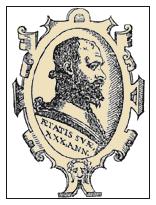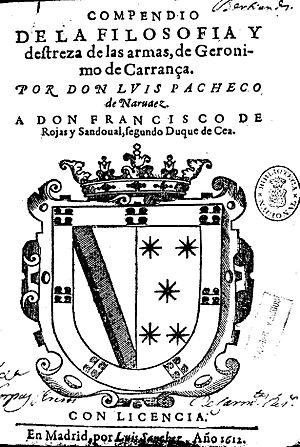Jerónimo Sánchez de Carranza facts for kids
Quick facts for kids
Jerónimo Sánchez de Carranza
|
|
|---|---|
 |
|
| Born | c. 1539 |
| Died | c. 1600 |
| Occupation | First in the science of handling weapons |
| Notable works | Founder of the Spanish school of fencing, destreza |
Don Jerónimo Sánchez de Carranza (born around 1539, died around 1600 or 1608) was a Spanish nobleman and scientist. He was one of the most famous fencers of his time. He is best known for creating a special Spanish way of fencing called destreza.
Carranza wrote an important book about fencing called De la Filosofía de las Armas y de su Destreza y la Aggression y Defensa Cristiana (which means 'The Philosophy of Arms'). This book was published in 1582. Carranza's ideas helped shape what a noble person should be: someone who was both a poet and a warrior.
His work on fencing was very important in Spain. It started a fighting style that was used for almost 300 years! Because he started destreza, Jerónimo de Carranza is often called "the pioneer of the science of handling weapons." His ideas were continued by his students, like Luis Pacheco de Narváez, and a Dutch fencing master named Gérard Thibault d'Anvers. These people added philosophical and moral ideas to Carranza's system, helping the Spanish fencing school grow even more.
Jerónimo Carranza's Life Story
Jerónimo Sánchez de Carranza was born in Seville, Spain, around 1539. He went to universities in Seville and Salamanca to get his education.
In the early 1560s, he moved to a city called Sanlúcar de Barrameda. There, he started working for the Duke of Medina Sidonia. Carranza even joined the duke in a military campaign to the Algarve. This campaign helped Philip II of Spain become the king of Portugal. Because of his good service to the Spanish king, Carranza became a knight. He was also given an important position in the Order of the Image of Christ.
During this time, Carranza wrote his famous book, De la Filosofía de las Armas ('The Philosophy of Arms').
In 1584, he moved to Madrid and worked as a judge. Five years later, he was chosen to be the governor of Honduras. While in Honduras, he faced some challenges with local officials. In 1595, he successfully fought off a group of French privateers (sailors who attacked ships for their country) who landed near Puerto Caballos. After his time as governor ended in 1596, he moved to Santiago de Guatemala. There, he took on a new job as a jurist, which is like a legal expert.
He likely passed away in Guatemala around 1608.
His Family
Jerónimo de Carranza had several children with Catalina Perez de Aguilar from Sanlúcar. Two of his sons, Gil Sanchez de Carranza and Geronimo Sancho de Carranza, went with him to Honduras. Sadly, Gil Sanchez de Carranza died in 1606 while returning from the Philippines.
About The Philosophy of Arms
Sánchez de Carranza wrote his book, De la Filosofía de las Armas ('The Philosophy of Arms'), while working for the Duke of Medina Sidonia. The book was only published once, in 1582, in Sanlúcar de Barrameda.
This book is written as a series of conversations, like a dialogue. It introduces a new way of fencing. Carranza called his work "The philosophy of weapons and the art of fencing" because it wasn't just about how to fight. It also focused on the deeper ideas behind it. He included ideas from famous thinkers like Plato and Aristotle.
In his book, Carranza also talked about other subjects. These included medicine, mathematics, geometry, and ethics (which is about right and wrong). He created a special idea called "philosophical fencing" (esgrima filosófica). This was a unique way of thinking about combat in European martial arts history.
The conversations in the book involve four people. These characters discuss the true art of fencing. The real names of these people were Carranza himself, the poet Fernando de Herrera, the humanist Juan de Mal Lara, and the doctor Pedro de Peramato.
Carranza believed that a true warrior should also be a learned person. This means someone who is smart, well-read, and can use science to understand and explain their skills. He wanted to show that fencing was not just physical. It was also a science and a philosophy.
D. Gómez Arias de Porres, another fencing master, wrote about Carranza's work. In his book, Resumen de la verdadera destreza en el manejo de la espada ('Summary of true swordsmanship skills'), he said:
I would also like to mention my colleague Jerónimo de Carranza, because thanks to his enormous efforts, it was possible to strengthen the strength of the spirit of many men, primarily in the world and in war ...
See also
 In Spanish: Jerónimo Sánchez de Carranza para niños
In Spanish: Jerónimo Sánchez de Carranza para niños


